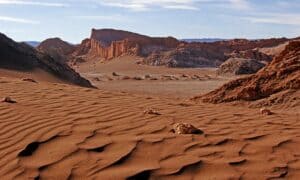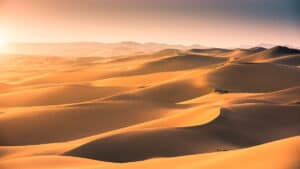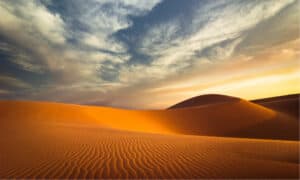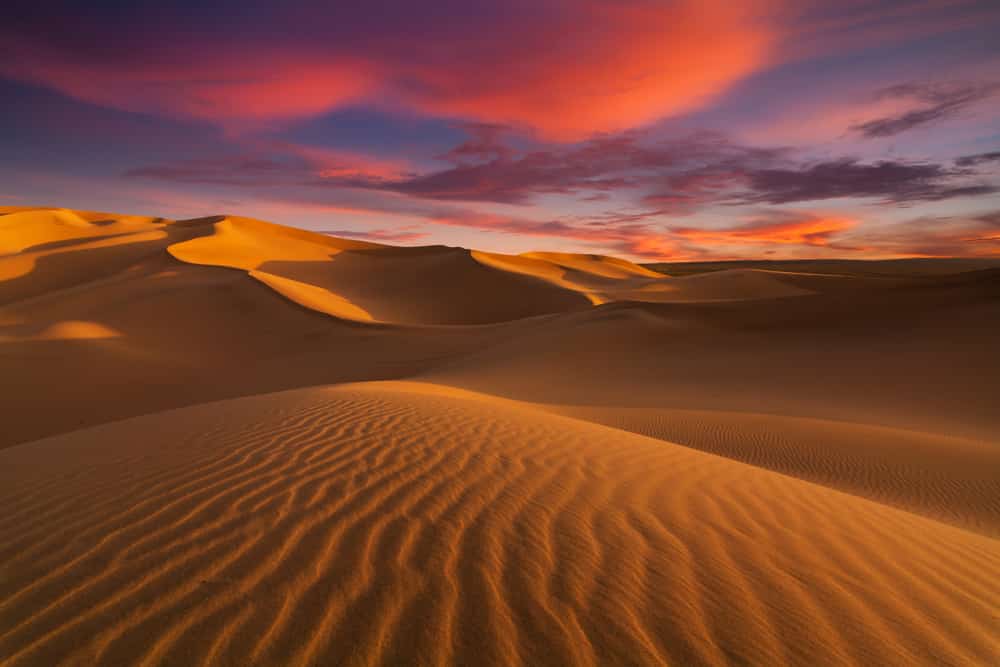
See the majestic Sahara at dusk, with the setting sun casting long shadows, as the desert prepares for the night and its temperature-driven dynamics.
©fogcatcher/Shutterstock.com
Ah, the Sahara. Its name instantly paints a picture of vast golden dunes stretching under a relentless sun. But there’s another side to this iconic desert, one that’s a bit more turbulent.
Imagine the sky darkening and the world around you turning into a swirling, sandy haze. This isn’t just a poetic description; it’s a reality for many in the Sahara. Sandstorms, nature’s sandy tantrums, are frequent and formidable visitors here. And while they might seem unpredictable, there’s a rhythm and reason to their occurrence.
Curious about what drives these towering walls of sand or how often they sweep across the Sahara? Dive in as we unravel the mysteries of Sahara sandstorms. Hold onto your hats (literally), and let’s get started!
Unveiling the Sandstorm: Nature’s Desert Drama
Have you ever been engrossed in a film where, out of the blue, the vibrant blue sky morphs into a swirling canvas of brown, and characters scramble to shield themselves from a gritty onslaught? That intense scene, my friend, is Hollywood’s portrayal of a sandstorm.
But let’s pull back the curtain and look beyond the silver screen.
A sandstorm isn’t just a director’s tool for dramatic effect. It’s one of nature’s most awe-inspiring performances. When the winds, those unseen artists of the desert, decide to flex their muscles, they scoop up sand and dust, sending them into a frenzied dance in the air. This results in a dense, roving cloud that can obscure the sun and transform day into an eerie twilight. If you’ve heard of a dust devil, think of a sandstorm as its mightier, more majestic sibling.
Now, let’s set our sights on where these sandstorms often play out: the Sahara. Picture an endless canvas, where every grain of sand tells a story, and the dunes rise like golden sculptures crafted by time and wind. Spanning a staggering 9.4 million square kilometers, the Sahara wears the crown as the third-largest desert, with only the frosty expanses of Antarctica and the Arctic outdoing it in size.
But, while those two are realms of cold silence, the Sahara pulsates with life and energy. It’s not just a barren wasteland dotted with camels. The Sahara is a symphony of scorching heat, undulating dunes, vibrant cultures, and, yes, those dramatic sandstorms. Far from being just a hot, sandy expanse, the Sahara stands as a testament to nature’s endless creativity and power.
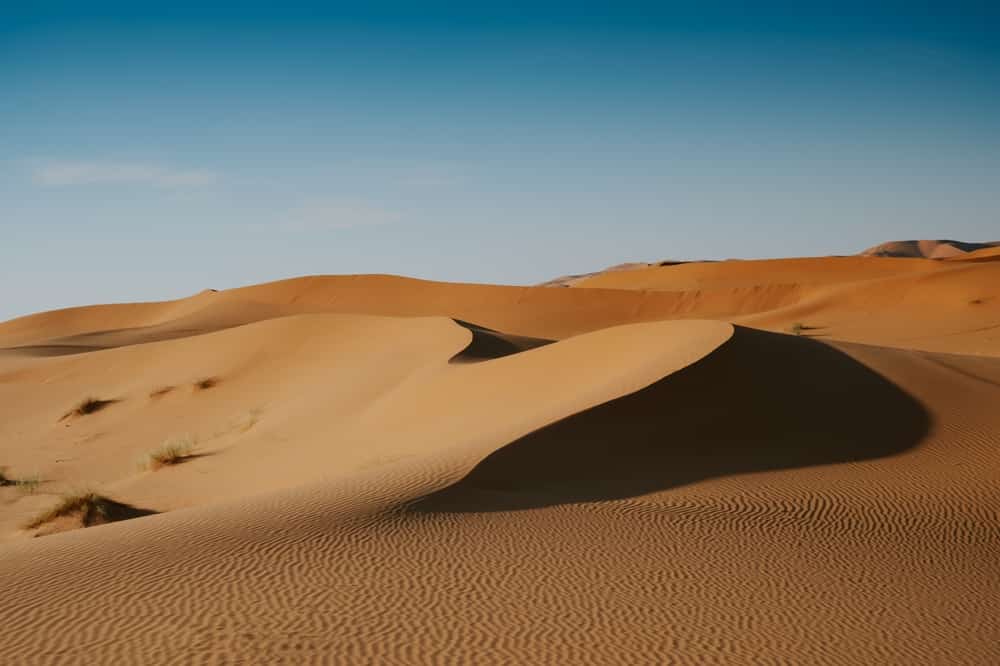
The aftermath of a sandstorm means a transformed landscape with new patterns etched onto the desert floor.
©James Nardelli/Shutterstock.com
Sahara’s Sandy Spectacles: The Whys Behind Sandstorms
The Sahara, a vast tapestry of golden hues stretching across the horizon, is an unmistakable part of nature’s grandeur. Among its wonders, sandstorms emerge as both magnificent and formidable forces. These aren’t mere figments of the imagination; they’re tangible, powerful phenomena that can turn the tranquil desert vista into a swirling tempest of sand.
But what brews these sandy maelstroms in the heart of the Sahara?
Let’s journey deeper into the desert to unravel the mysteries behind these storms.
Natural Causes
The Sahara, with its sprawling landscapes and ever-evolving topography, is naturally inclined to birth sandstorms. The intrinsic characteristics of the desert, from its dynamic dunes to the whimsical winds, are instrumental in orchestrating these sandy spectacles. But there’s more to the story than just winds and shifting sands.
Wind Patterns
Imagine the Sahara as an expansive stage, set and ready for the winds to narrate their epic. These winds aren’t just whispers; they’re the maestros of the desert, brandishing their power with gusto, scooping up and spiraling vast swathes of sand into the atmosphere. The direction they choose, the force they exert, and the paths they carve are pivotal in shaping the narrative of the sandstorm.
Desertification
The Sahara’s flora, often referred to as its silent sentries, plays a crucial role in anchoring the vast stretches of sand. These plants, with their deep roots, act as nature’s grip, holding the desert floor together. However, as desertification progresses, claiming these green guardians, larger areas of sand are left vulnerable. Without their protective embrace, these sands are easily unmoored, becoming playthings for the winds, leading to frenzied sandstorms that dance across the desert.
Topography
The Sahara’s unique topography, featuring vast plains juxtaposed with majestic dunes and punctuated by sporadic mountain ranges, plays a pivotal role in sandstorm formation. These geographical features act as nature’s wind tunnels, directing, and sometimes intensifying, the winds. Such channeled winds, with their enhanced vigor, become masterful at lifting and transporting sand.
Temperature
Every day, the Sahara Desert’s temperature rises and falls. The scorching heat of the day gracefully gives way to the cooler embrace of the night. This dramatic shift doesn’t just offer relief; it stirs the air, creating turbulent movements. This dance of temperatures, in turn, awakens the winds, energizing them to become formidable forces capable of lifting vast amounts of sand.
Drought and Dry Spells
The Sahara, despite its inherent aridity, feels the pangs of thirst during prolonged dry spells. As the land parches, even more, sand is exposed, devoid of the moisture that once held it together. This heightened vulnerability sets the perfect stage for intense, sweeping sandstorms that can engulf vast regions.
Nature’s Unexpected Twists
The Sahara, in all its predictability, has its moments of unexpected drama. Events like earthquakes can jolt the desert, disrupting its usually stable crust. And on the rare occasion, a flash flood might surge through, eroding and unsettling the once-stable soil. While these events might be few and far between, they introduce an added dimension to the intricate dynamics of Sahara’s sandstorms.
Seasonal Rhythms
The Sahara, like an expert dancer, moves to the ebb and flow of seasonal rhythms. There are times, like during the onset of the dry Harmattan wind in winter, when the desert seems more restless. These seasonal shifts often signal heightened sandstorm activity, casting a sandy veil across the brilliant blue skies.
In short, the Sahara’s sandstorms are intricately choreographed by a blend of natural elements and evolving environmental conditions. As we peel back the layers, we gain a deeper appreciation of the desert’s ever-changing moods and marvels.
Man-Made Catalysts
Nature, in its timeless rhythm, has always been the primary choreographer of the Sahara’s dance. However, in recent times, humans have stepped onto this vast stage, adding their own moves and sometimes disrupting the desert’s age-old waltz. Our actions, driven by ambition, necessity, or sometimes mere oversight, have woven new threads into the Sahara’s story, influencing the frequency, intensity, and very nature of its sandstorms.
Land Mismanagement
Our quest for sustenance and progress often blinds us to the delicate symphony of ecosystems. In the rush to extract the desert’s bounties, practices like overgrazing by livestock or unsustainable farming methods can strip the land of its natural resources and defenses – namely its greenery. This green shield, once robust and protective, thins out, leaving vast stretches of sand vulnerable to the whims of the wind.
Urbanization’s Footprint
As humanity’s footprint expands, cities and infrastructures creep ever closer to the desert’s fringes. This march of modernization, while a testament to human ingenuity, disrupts the Sahara’s natural equilibrium. By reshaping the terrain and altering its composition, we inadvertently modify the desert’s wind patterns. The outcome? Regions, especially those neighboring urban sprawls, become hotspots for intensified sandstorm activity.
Water Extraction
Our insatiable thirst leads to extensive groundwater extraction in desert regions. Over time, this can deplete natural underground reservoirs, leading to land subsidence and further desertification, making areas more prone to sandstorms.
Deforestation
In areas where the desert meets more vegetative landscapes, deforestation for timber or to clear land for agriculture can exacerbate desertification. Trees, nature’s windbreakers, once removed, allow winds to sweep across the land with greater force, picking up and transporting sand more easily.
Infrastructure Projects
Large-scale projects, like building roads or dams, can disturb the natural topography and soil composition. Such disruptions, even if localized, can have cascading effects, leading to increased susceptibility to sandstorms in the affected areas.
Pollution and Climate Change
Industrial activities release pollutants that can impact local climates. Over time, these changes can lead to altered wind patterns and reduced rainfall, both of which can intensify desert conditions and the potential for sandstorms.
In the grand tapestry of the Sahara’s tale, human-induced causes have added new, often complex, patterns. While nature has its inherent rhythms, our interventions have introduced a dynamic interplay of forces. Recognizing and understanding our role in this evolving dance is crucial, not just for the Sahara’s narrative but for the broader story of our planet’s future.
Navigating Nature’s Sandy Spectacles: A Guide to Surviving Sahara’s Sandstorms
The Sahara, with its mesmerizing dunes that seem to dance with the winds and its vast landscapes that stretch as far as the eye can see, is a world of wonder. But, like any great story, it has its dramatic moments, and sandstorms are its most thrilling chapters. These swirling tempests of sand are as much a part of the desert’s narrative as its tranquil sunsets. For those who tread its terrains, be it the seasoned local or the adventurous traveler, understanding and preparing for these sandy onslaughts is paramount.
Precautions for Travelers
Embarking on a journey to the Sahara or any of its desert cousins is not just about packing your camera and sunscreen. The desert, in all its beauty, demands respect and preparation, especially when it comes to its unpredictable sandstorms.
Stay Informed
Knowledge is your best ally. Before setting foot in the desert, arm yourself with information. Regularly check local weather updates and be on the lookout for sandstorm advisories. There are several dedicated apps and websites that cater specifically to desert regions, offering real-time insights into potential sandstorm occurrences.
Gear Up
Think of a sandstorm, and you might picture a scene from an adventure movie. But experiencing one firsthand requires more than just dramatic music. Equip yourself with a sandstorm survival kit. This should include protective goggles to guard your eyes from the stinging sand, face masks or breathable scarves to filter out the gritty air, and a sturdy hat, preferably with a wide brim, to offer an added layer of defense against the relentless grains.
Know the Drill
The desert can be unpredictable, and you might find yourself amidst a sandstorm despite your best preparations. In such situations, knowing how to react can make all the difference. Your first instinct should be to find shelter, be it a nearby building, tent, or even your vehicle. If these aren’t within reach, turn away from the wind, shield your face using your hands or clothing, and crouch low to the ground where the air tends to be less saturated with sand. Patience is key; wait for the storm to subside before resuming your journey.
In the grand theater of the Sahara, sandstorms are dramatic interludes, reminding us of nature’s power and unpredictability. Whether you’re a visitor seeking adventure or a local living amidst the dunes, understanding and respecting these sandy spectacles is essential for a safe desert experience.

Golden dunes of the Sahara are disrupted moments before a sandstorm begins its mesmerizing dance.
©Peter116/Shutterstock.com
Impact on Local Communities
For the indigenous communities that have called the Sahara home for generations, sandstorms are more than just occasional disruptions; they’re a part of the desert’s rhythm. Their deep-rooted connection to the land has fostered a resilience and adaptability that’s truly admirable.
Architectural Adaptations
Over the years, local communities have perfected the art of building homes tailored to withstand the desert’s challenges. Thick walls, minimal windows, and strategic orientations are common features, ensuring interiors remain as sand-free as possible.
Daily Routines
Life doesn’t come to a standstill during a sandstorm. Locals have established routines that allow them to continue their daily tasks with minimal disruption. This includes covering water sources, securing livestock, and even adjusting work hours to avoid peak storm times.
Community Support
The communal spirit shines during these challenging times. Neighbors assist one another, ensuring the elderly and children are safe, sharing resources, and pooling knowledge. This collective approach not only helps in immediate sandstorm management but also in preserving and passing down coping strategies to younger generations.
In essence, the Sahara, with its beauty and challenges, offers a profound lesson in resilience, adaptability, and the enduring bond between humans and their environment.

The serene calm of the Sahara is juxtaposed against the distant, looming haze of an approaching sandstorm.
©ABDULLAHNALMAMARI/Shutterstock.com
Desert Dynamics: Deciphering the Sahara’s Sandy Signals
The Sahara, often painted in our minds as an endless sea of golden tranquility, is also a dynamic and ever-evolving entity. Our exploration into the Sahara has shed light on the myriad factors that give rise to these awe-inspiring phenomena. It’s not merely the desert throwing a tantrum; it’s a complex interplay of natural rhythms and human interventions.
The causes of these sandstorms, from the desert’s own shifting topography and climatic dances to the imprints of human activity, weave a tale of interconnectedness. The frequency with which these storms occur, especially in transitional seasons, underscores the Sahara’s sensitivity to both its inherent cycles and external influences.
As we reflect on the intricate web of causes and their manifestations in the form of sandstorms, it becomes evident that the Sahara is not just a passive backdrop in the global ecosystem. It’s an active participant, responding to changes, signaling shifts, and reminding us of the delicate balance that exists in nature.
FAQs: Unraveling the Mysteries of Sahara’s Sandstorms
The Sahara, with its vastness and enigma, often leaves us with more questions than answers. And when it comes to its iconic sandstorms, the intrigue only deepens. Let’s dive into some of the most frequently asked questions about these sandy spectacles and shed some light on their mysteries.
1. How long do sandstorms typically last in the Sahara?
Much like market fluctuations, sandstorms can vary in duration. They might be brief, lasting just a few minutes, similar to a short-lived market dip. On the other hand, they can extend for several days, akin to a prolonged market downturn. The exact duration depends on specific environmental conditions.
2. Is it advisable for business operations or travel in the Sahara during the sandstorm season?
Operating in the Sahara during sandstorm season is much like navigating a volatile market. While it’s not inherently risky, the key is thorough preparation. Ensure teams are equipped with up-to-date information, appropriate protective gear, and a mindset ready to adapt to changing conditions.
3. How have animals in the Sahara adapted to sandstorms?
The wildlife in the Sahara showcases resilience and adaptability, much needed in the business realm. Over time, many animals have evolved specific strategies, such as burrowing or having protective eyelids, to cope with the challenges of sandstorms.
4. Are sandstorms exclusive to the Sahara?
No, while the Sahara is often associated with sandstorms, it’s not the only desert that experiences them. Deserts worldwide, from the Middle East to other parts of Asia, also witness these sandy phenomena. Each region, with its distinct topography and climate, contributes its unique characteristics to sandstorms.
5. Do the Sahara’s sandstorms influence global weather patterns?
Yes, the impact of the Sahara’s sandstorms extends beyond its borders. The dust from these storms can travel across continents, affecting weather patterns and even influencing phenomena like rain and snow in far-off regions.
In essence, the Sahara, with its sandstorms, is a storyteller. Each gust of wind, each grain of sand carries tales of the past, and present, and hints of the future. As we seek to understand these tales, it’s essential to approach them with curiosity, respect, and a sense of wonder. After all, every whisper of the desert holds a lesson, waiting to be unraveled.
The photo featured at the top of this post is © James Nardelli/Shutterstock.com
Thank you for reading! Have some feedback for us? Contact the AZ Animals editorial team.




